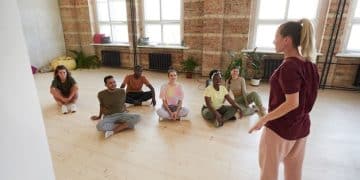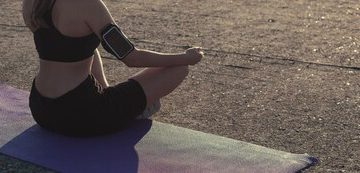The Ultimate Guide to Progressive Muscle Relaxation: Reduce Tension Fast
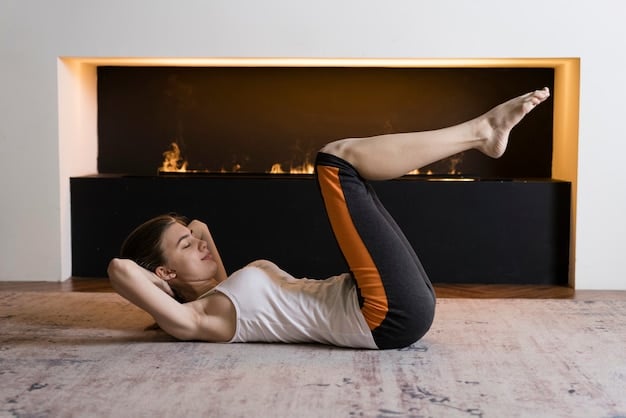
Progressive Muscle Relaxation (PMR) is a simple and effective technique that can significantly reduce tension in just 10 minutes by systematically tensing and relaxing different muscle groups in the body.
Feeling stressed or tense? The ultimate guide to progressive muscle relaxation offers a quick and easy way to reduce tension in just 10 minutes, helping you achieve a state of calm and relaxation.
Understanding Progressive Muscle Relaxation
Progressive Muscle Relaxation (PMR) is a technique developed by Dr. Edmund Jacobson in the 1920s. It’s designed to reduce anxiety and muscle tension by teaching you to recognize the difference between muscle tension and relaxation. This awareness allows you to consciously relax your muscles, leading to a decrease in overall stress levels.
By practicing PMR regularly, you can become more attuned to your body’s signals of tension and learn to release that tension before it escalates into significant stress or pain. Let’s explore how this technique works and its benefits.
The Science Behind PMR
The effectiveness of PMR lies in its ability to activate the body’s relaxation response. When you tense a muscle group, you’re essentially creating a controlled stressor. When you release that tension, your body experiences a sense of relief, triggering the parasympathetic nervous system, which is responsible for rest and recovery.
This process helps to lower your heart rate, blood pressure, and breathing rate, all of which are elevated during times of stress. PMR also encourages the release of endorphins, natural mood boosters that further contribute to relaxation and well-being.
Key Benefits of Progressive Muscle Relaxation
- Reduces Anxiety: PMR helps lower anxiety levels by promoting relaxation and reducing muscle tension.
- Improves Sleep: Regular practice can improve sleep quality by calming the mind and body before bedtime.
- Manages Pain: PMR can be effective in managing chronic pain conditions, such as headaches and back pain.
- Lowers Blood Pressure: By activating the relaxation response, PMR can help lower blood pressure and improve cardiovascular health.
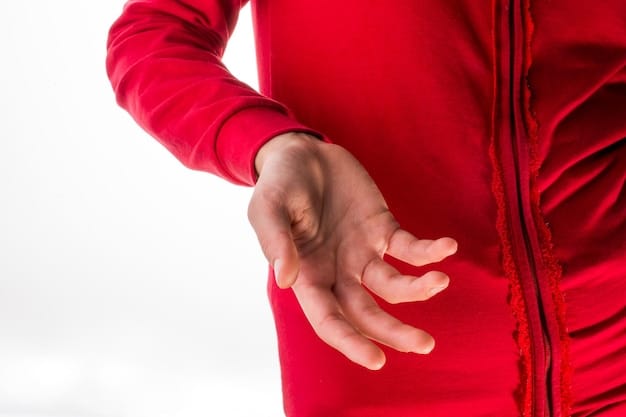
Progressive Muscle Relaxation offers a holistic approach to stress management, addressing both the physical and mental aspects of stress. Understanding the science and benefits behind PMR can motivate you to incorporate this technique into your daily routine.
Preparing for Your PMR Session
Before you begin your PMR session, it’s essential to create an environment that promotes relaxation and minimizes distractions. Taking a few moments to prepare can significantly enhance the effectiveness of the exercise.
This preparation involves finding a quiet space, wearing comfortable clothing, and adopting a relaxed posture. These simple steps can help you fully immerse yourself in the practice and reap its benefits. Here’s how to prepare for PMR.
Finding a Quiet Space
Choose a location where you’re unlikely to be disturbed. This could be your bedroom, a quiet corner of your home, or even a peaceful outdoor spot, weather permitting. Ensure that the space is free from noise and interruptions.
Consider using noise-canceling headphones or playing calming music to further minimize distractions. The goal is to create a serene environment where you can fully focus on your body and breath.
Comfortable Clothing and Posture
Wear loose-fitting clothes that allow you to move freely and comfortably. Avoid anything that feels restrictive or tight. You can practice PMR either sitting or lying down, depending on your preference.
If sitting, choose a chair that supports your back and allows you to keep your feet flat on the floor. If lying down, use a comfortable mat or blanket. The key is to adopt a posture that supports relaxation and minimizes strain.
Mindful Breathing
- Deep Breaths: Begin by taking a few deep breaths to center yourself and calm your mind. Inhale slowly through your nose, filling your lungs completely, and exhale slowly through your mouth.
- Focus on Breath: Pay attention to the sensation of the air entering and leaving your body. This can help you to quiet your thoughts and focus on the present moment.
- Gentle Pace: Maintain a gentle and rhythmic breathing pattern throughout the exercise. Avoid holding your breath or breathing too quickly.
Proper preparation sets the stage for a successful PMR session. By creating a calm environment and focusing on your breath, you can enhance your ability to relax and release tension.
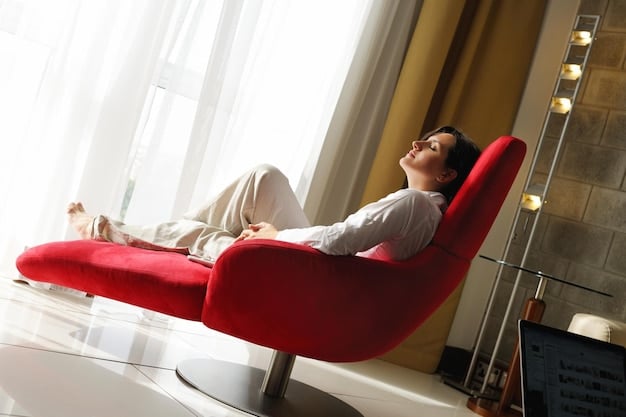
Step-by-Step Guide to PMR
Now that you’re prepared, let’s dive into the actual practice of Progressive Muscle Relaxation. This step-by-step guide will walk you through each muscle group, guiding you to tense and relax in a systematic way. Remember to listen to your body and avoid tensing any muscle to the point of discomfort or pain.
Each exercise should be performed with mindful awareness, paying attention to the sensations of tension and release. Follow these steps to experience the full benefits of PMR.
Hands
Start by making a tight fist with both hands. Tense your hands as tightly as you can, noticing the tension in your fingers, palms, and forearms. Hold this tension for about 5-10 seconds.
Then, slowly release the tension, allowing your hands to relax completely. Pay attention to the feeling of relaxation as the tension dissipates. Repeat this exercise 1-2 times.
Arms
Extend your arms straight out in front of you and tense your biceps by making a strong flexing motion. Feel the tension in your upper arms. Hold this tension for 5-10 seconds.
Release the tension gradually, letting your arms relax and return to a neutral position. Notice the contrast between the tension and relaxation. Repeat this exercise 1-2 times.
Shoulders
- Shrugging: Shrug your shoulders up towards your ears, tensing the muscles in your neck and upper back. Hold for 5-10 seconds.
- Releasing: Release your shoulders, letting them drop back down to a relaxed position. Notice the feeling of release in your neck and upper back. Repeat 1-2 times.
- Awareness: Focus on the difference between the tense and relaxed states.
By following this step-by-step guide, you can effectively practice Progressive Muscle Relaxation and experience its stress-reducing benefits. Remember to move slowly and mindfully, paying attention to the sensations in your body.
Tips for Maximizing Your PMR Practice
To get the most out of your Progressive Muscle Relaxation practice, consider incorporating a few additional tips and techniques. Consistency, mindful awareness, and personalized adjustments can enhance the effectiveness of PMR and help you achieve a deeper state of relaxation.
By following these tips, you can optimize your PMR sessions and experience even greater stress reduction and overall well-being. Let’s explore these tips in more detail.
Consistency is Key
Like any skill, PMR becomes more effective with regular practice. Aim to practice PMR at least once a day, or whenever you feel particularly stressed or tense. Consistency helps you to become more attuned to your body’s signals and more skilled at releasing tension.
Even short, 10-minute sessions can be beneficial. The key is to make PMR a regular part of your routine, just like brushing your teeth or exercising.
Mindful Awareness
Pay attention to the sensations in your body as you tense and release each muscle group. Notice the difference between tension and relaxation. This mindful awareness can help you to identify and release tension more effectively.
Avoid simply going through the motions. Instead, fully engage your senses and focus on the present moment. This will enhance the relaxation response and promote a greater sense of calm.
Personalize Your Practice
- Adjustments: Feel free to adjust the order or duration of the muscle groups to suit your individual needs and preferences.
- Focus Areas: If you tend to hold tension in certain areas of your body, spend more time focusing on those muscle groups.
- Comfort: Ensure that you are comfortable and relaxed throughout the exercise. Modify your posture or environment as needed.
By incorporating these tips into your PMR practice, you can maximize its benefits and achieve a deeper state of relaxation. Consistency, mindful awareness, and personalization are key to unlocking the full potential of this powerful technique.
Common Mistakes to Avoid in PMR
While Progressive Muscle Relaxation is a relatively simple technique, there are some common mistakes that people often make. Avoiding these mistakes can help you to ensure that you’re practicing PMR correctly and effectively.
Being aware of these pitfalls and taking steps to avoid them can significantly improve your PMR practice. Let’s take a look at some common mistakes and how to prevent them.
Tensing Too Much
It’s important to tense each muscle group, but avoid tensing to the point of pain or discomfort. The goal is to create a moderate level of tension, not to strain your muscles. If you experience any pain, reduce the amount of tension or skip that muscle group altogether.
Remember, PMR is about relaxation, not exertion. Gentle, controlled tension is all that’s needed to activate the relaxation response.
Rushing Through the Exercise
Take your time as you move through each muscle group. Avoid rushing through the exercise or skipping steps. Each phase of the exercise – tensing, holding, and releasing – is important for promoting relaxation.
Allow yourself to fully experience the sensations of tension and release. This mindful approach will enhance the effectiveness of PMR and help you to achieve a deeper state of calm.
Not Focusing on Relaxation
- Attention: Pay attention to the feeling of relaxation as you release the tension in each muscle group. This is a crucial part of the exercise.
- Awareness: Focus on the contrast between the tense and relaxed states. This will help you to become more attuned to your body’s signals and more skilled at releasing tension.
- Mindfulness: Avoid letting your mind wander. Instead, focus on the present moment and the sensations in your body.
By avoiding these common mistakes, you can ensure that you’re practicing Progressive Muscle Relaxation correctly and effectively. Remember to tense gently, move slowly, and focus on the feeling of relaxation.
Integrating PMR into Your Daily Life
Progressive Muscle Relaxation can be easily integrated into your daily life, providing you with a convenient and effective way to manage stress and promote relaxation. Whether you have a few minutes to spare or want to dedicate a longer session, PMR can be adapted to fit your schedule and needs.
By finding creative ways to incorporate PMR into your routine, you can make stress management a seamless part of your lifestyle. Let’s explore some practical strategies for integrating PMR into your daily life.
Quick Relaxation Breaks
Use PMR as a quick relaxation break during your workday or whenever you feel stressed. Even a few minutes of PMR can help to reduce tension and improve your focus.
Focus on a few key muscle groups, such as your hands, shoulders, and neck. Tense and release each group 2-3 times, paying attention to the sensations of relaxation.
Before Bedtime
Practice PMR before bedtime to calm your mind and body and promote restful sleep. This can be especially helpful if you struggle with insomnia or have difficulty winding down at night.
Lie down in a comfortable position and move through each muscle group, starting with your toes and working your way up to your head. Focus on releasing any tension you’re holding and allowing your body to relax completely.
During Stressful Situations
- Awareness: Use PMR as a coping mechanism during stressful situations, such as a difficult meeting or a traffic jam.
- Subtlety: Practice PMR discreetly by focusing on a few key muscle groups, such as your hands or shoulders.
- Mindfulness: This can help you to reduce tension and regain control of your emotions.
By integrating PMR into your daily life, you can make stress management a regular and seamless part of your routine. Whether you have a few minutes to spare or want to dedicate a longer session, PMR can be adapted to fit your schedule and needs.
| Key Point | Brief Description |
|---|---|
| 🧘♀️ What is PMR? | A technique for reducing anxiety and muscle tension by tensing and relaxing muscle groups. |
| ⏱️ How Long? | Typically takes about 10-20 minutes to complete a full session. |
| 😌 Benefits | Reduces anxiety, improves sleep, manages pain, and lowers blood pressure. |
| 💡 Key Tips | Be consistent, focus on sensations, and personalize the sequence. |
Frequently Asked Questions About Progressive Muscle Relaxation
▼
PMR is a relaxation technique where you tense and release different muscle groups. This process helps to reduce muscle tension and promote relaxation by triggering the body’s natural relaxation response.
▼
A full PMR session usually takes between 10 to 20 minutes. However, you can also do shorter sessions focusing on specific muscle groups if you have limited time.
▼
Yes, PMR can be very effective for improving sleep. By reducing muscle tension and quieting the mind, it helps prepare the body for rest and can alleviate insomnia symptoms.
▼
PMR is generally safe, but if you have any physical limitations or chronic pain, consult with a healthcare provider before starting. They can provide guidance to ensure your safety and comfort during the exercises.
▼
For best results, practice PMR daily or at least several times a week. Consistent practice will help you become more attuned to your body’s tension and more skilled at releasing it.
Conclusion
The ultimate guide to progressive muscle relaxation provides a useful tool for managing stress and promoting well-being. By incorporating this simple technique into your daily routine, you can reduce tension, improve sleep, and enhance your overall quality of life.
